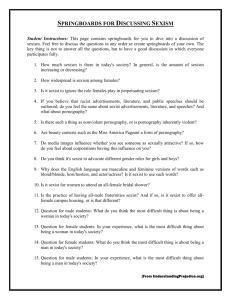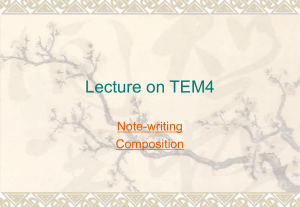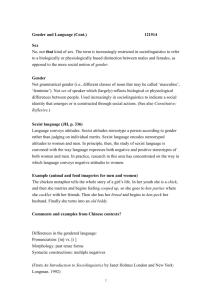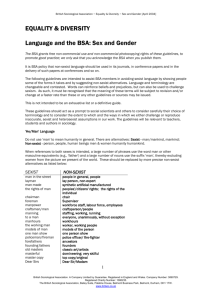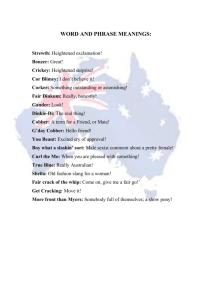sexist language shell
advertisement
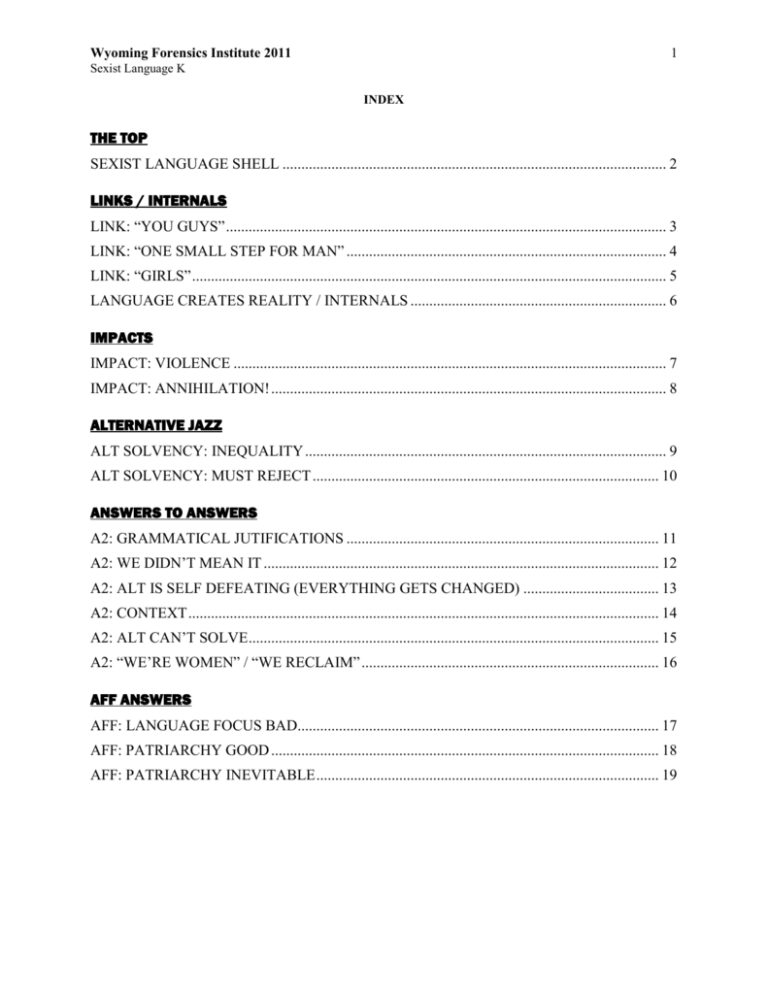
Wyoming Forensics Institute 2011 1 Sexist Language K INDEX THE TOP SEXIST LANGUAGE SHELL ...................................................................................................... 2 LINKS / INTERNALS LINK: “YOU GUYS” ..................................................................................................................... 3 LINK: “ONE SMALL STEP FOR MAN” ..................................................................................... 4 LINK: “GIRLS” .............................................................................................................................. 5 LANGUAGE CREATES REALITY / INTERNALS .................................................................... 6 IMPACTS IMPACT: VIOLENCE ................................................................................................................... 7 IMPACT: ANNIHILATION! ......................................................................................................... 8 ALTERNATIVE JAZZ ALT SOLVENCY: INEQUALITY ................................................................................................ 9 ALT SOLVENCY: MUST REJECT ............................................................................................ 10 ANSWERS TO ANSWERS A2: GRAMMATICAL JUTIFICATIONS ................................................................................... 11 A2: WE DIDN’T MEAN IT ......................................................................................................... 12 A2: ALT IS SELF DEFEATING (EVERYTHING GETS CHANGED) .................................... 13 A2: CONTEXT ............................................................................................................................. 14 A2: ALT CAN’T SOLVE ............................................................................................................. 15 A2: “WE’RE WOMEN” / “WE RECLAIM” ............................................................................... 16 AFF ANSWERS AFF: LANGUAGE FOCUS BAD................................................................................................ 17 AFF: PATRIARCHY GOOD ....................................................................................................... 18 AFF: PATRIARCHY INEVITABLE ........................................................................................... 19 Wyoming Forensics Institute 2011 2 Sexist Language K SEXIST LANGUAGE SHELL [INSERT A LINK IF YOU NEED ONE] LANGUAGE SHAPES REALITY – SEXIST LANGUAGE CREATES SYSTEMS OF DOMINATION AND PATRIARCHY Janet B. Parks & Mary Ann Robertson (Bowling Green State University) 2004 [“Attitudes toward women mediate the gender effect on attitudes towards sexist language” Psychology of Women Quarterly vol. 28, loghry] Sexist language includes “words, phrases, and expressions that unnecessarily differentiate between women and men or exclude, trivialize, or diminish either gender” (Parks & Roberton, 1998a, p. 455). According to Miller and Swift (1988), examples of sexist language are false generics such as “he” and “mankind”; hierarchic and separatist terms, such as “man and wife”; and terms that influence women’s self-esteem or identity, such as using “girl” to refer to an adult woman. Research has shown that sexist language can suggest that the masculine is the norm (Hamilton, 1991; Hyde, 1984), create masculine images in the mind of the listener (Gastil, 1990; Hamilton, 1988; McConnell & Fazio, 1996; Ng, 1990), and limit perceptions of vocational options (Briere & Lanktree, 1983; Dayhoff, 1983). Scholars have also noted that sexist language reinforces the superiority of men and perpetuates male privilege in society (Kleinman, 2002; Shute, 1981). It also affects the gender schemas of girls and boys (Hyde, 1984). Although sexist language can be directed toward men, studies in Englishspeaking cul- tures have established that its deleterious and disempower- ing effects typically accrue to women (Briere & Lanktree, 1983; Dayhoff, 1983; Gastil, 1990; Hamilton, 1988; Hyde, 1984; Schau & Scott, 1984). In addition to these practical implications, theoretical controversy about sexist language has centered on Benjamin Whorf’s (1940/1956a, 1941/1956b) assumption of a rela- tionship between language and culture. Whorf’s principle of linguistic relativity posited that language and cultural pat- terns have a reciprocal relationship, that they “have grown up together and constantly influence each other” (Whorf, 1941/1956b, p. 156). From his perspective, the power of lan- guage is its ability both to construct and to reflect societal belief systems (Bing, 1992; Miller & Swift, 1988; Spender, 1990). REGARDLESS OF INTENTION, SEXIST LANGUAGE MAKES VIOLENCE AND DEHUMANIZATION INEVITABLE Sherryl Kleinman, et al (Sherryl Kleinman is Professor of Sociology at the University of North Carolina at Chapel Hill. Matthew B. Ezzell is a PhD candidate in Sociology at the University of North Carolina at Chapel Hill. A. Corey Frost received his B.A. in Sociology at the University of North Carolina at Chapel Hill) Spring 2009 [“Reclaiming Critical Analysis: The Social Harms of “Bitch”” Sociological Analysis, Vol. 3, No. 1, loghry] Words can elevate or deflate us, as children learn when they receive praise or blame from parents, teachers, and peers. Central to our analysis are the indirect effects of language. For example, despite people’s intentions, the telling of sexist and racist jokes can “sustain an environment in which people use sticks, stones, guns, or bombs against others” (Kleinman 2007: 13). Any terms that dehumanize others can make it easier for us to harm them (Schwalbe 2008). And words often precede action. Harsh words are exchanged and a fight breaks out. A speaker’s words move others to organize against injustice, or stop them from doing so. In addition, words are action: “With words as our daily tools, we can’t help but do things with them” (Kleinman 2007: 13). As these examples suggest, commonly used words can signify hierarchy. Words tell us, empirically, about: increases or decreases in inequality; old inequalities in new guises; false power among members of an oppressed group (more on that, later); unconscious sexism, racism, or other forms of inequality; subordinates’ resistance to injustice. Wyoming Forensics Institute 2011 3 Sexist Language K LINK: “YOU GUYS” “YOU GUYS” IS HOMOGINIZING AND ASSUMES THAT MALES ARE THE ONLY ONES WITH VALUE – ERASES WOMEN FROM DISCUSSION Sherryl Kleinman (Department of Sociology, University of North Carolina, Chapel Hill) Summer 2002 [“Why Sexist Language Matters” Qualitative Sociology, Vol. 25, No. 2, loghry] And why do so many women cling to “freshman,” “chairman,” and “you guys?” I think it’s because women want to be included in the term that refers to the higher-status group: men. But while being labeled “one of the guys” might make women feel included, it’s only a guise of inclusion, not the reality. If women were really included we wouldn’t have to disappear into the word “guys.” At the same time that women in my classes throw around “you guys”— even here in the southern United States, where “y’all” is an alternative—they call themselves “girls.” I’m not sure if this has gotten worse over the years or I’ve just noticed it more. When Iwas an undergraduate in the early to mid 1970s, wewanted to bewomen. Whowould take us seriously at college or atwork if we were “girls?” To many of my students today, “woman” is old enough to be “over the hill.” A “girl” is youthful and thus more attractive to men than a “woman.” Since they like the term so much, I suggest that we renameWomen’s Studies “Girls’ Studies.” And since the Women’s Center on campus provides services for them, why not call it “The Girls’ Center.” They laugh. “Girls” sounds ridiculous, they say. The students begin to see that “girl”—as a label for twenty-one-year-olds—is infantilizing, not flattering. “Girl” and “you guys” aren’t the only linguistic problems on campus. A few years ago Bob, a student in my class, said that his fraternity is now open to women as well as men and that a controversy had erupted over whether to continue to use the term “brother” to refer to all fraternity members, or to use “sister” for female members. Almost all the women in his fraternity, he said, voted to be called brother rather than sister. As with “you guys,” the women wanted to take on the word that has more value. Yet the practice of using “brother” reinforces the idea that a real member of the group is a brother (i.e., a man). I asked what would happen if he had suggested that all fraternity members be called sisters rather than brothers, or that they rename the fraternity a sorority. Everyone laughed at the absurdity of this suggestion. Exactly. Yet it is not absurd, but acceptable, to call women by the term “guys” or “brothers.” Wyoming Forensics Institute 2011 4 Sexist Language K LINK: “ONE SMALL STEP FOR MAN” NEILL ARMSTRONG’S “ONE SMALL STEP FOR MAN” LINE IS A CLEAR EXAMPLE OF SEXIST LANGUAGE DESIGNED TO PERPETUATE PATRIARCHY Lisa R. Sproul (M.S. student @ Univ. Wisconsin-Stout in guidance and counseling) May 2000 [“STUDENT'S PERCEPTIONS OF EFFECTIVE LEADERSHIP BASED ON BOTH THE GENDER OF THE STUDENT AND THE GENDER OF THE LEADER” Masters thesis, loghry] The concept of females being ignored in language goes a step further. Some examples are "one small step for man, one giant step for mankind or man overboard" to name a few. Just as equally concerning as females being ignored is the fact that these masculine images are believed to perpetuate in men a feeling of dominance over women (Richardson, 1987). The issue of language is believed to be an important one because it is another way that society reinforces the secondary role of women in society. That is why Amy Sheldon's (1990 p. 6) statement, "to improve our language is to improve our society" is so poignant. Wyoming Forensics Institute 2011 5 Sexist Language K LINK: “GIRLS” “GIRLS” AS A GENERIC TERM FOR WOMEN IS ANOTHER ILLUSTRATION OF SEXISM IN LANGUAGE Sherryl Kleinman, et al (Sherryl Kleinman is Professor of Sociology at the University of North Carolina at Chapel Hill. Matthew B. Ezzell is a PhD candidate in Sociology at the University of North Carolina at Chapel Hill. A. Corey Frost received his B.A. in Sociology at the University of North Carolina at Chapel Hill) Spring 2009 [“Reclaiming Critical Analysis: The Social Harms of “Bitch”” Sociological Analysis, Vol. 3, No. 1, loghry] But as Hofstadter (see also Richardson 2004) points out in detail, women are systematically made invisible in socalled generics, and there are hundreds more pejorative terms in English for women than for men, most of them sexual (Richardson 2004). So it makes sense to conclude that men are systematically privileged, and women disadvantaged, in the English language. As Hofstadter illustrates so well in “A Person Paper on Purity in Language”—in which he substitutes race for sex, and creates such terms as “freshwhite” and “you whiteys” in the place of “freshman” and “you guys”—the pattern of sexism is clear. Why did Hofstadter write his article as a satire? Doing so, he risked being seen as a racist by those who failed to understand it. He used terms with “white” and “black” in order to make sexist language, and other sexist practices, visible. Terms that regularly make women invisible are largely acceptable not only to men and boys, but also to women and girls. Readers will know from the context of this article that “girls” refers to female children. But “girls” is used increasingly in everyday speech to refer to women of just about any age. That female and male college students use “girls” to refer to college-aged women—and dislike the term “woman”— is yet another indicator of sexism. Wyoming Forensics Institute 2011 6 Sexist Language K LANGUAGE CREATES REALITY / INTERNALS LANGUAGE DOES CREATE REALITY – SEXIST LANGUAGE CAUSES TANGIBLE IMPACTS IN THE REALLY REAL WORLD Wendy Martyna (dept. of psychology, UCSC) Spring 1980 [“Beyond the "He/Man" Approach: The Case for Nonsexist Language” Signs, Vol. 5, No. 3, loghry] Why the persistent misrepresentation and misunderstanding of the sexist language issue?54 The simplest explanation is antifeminism, yet this by itself is not enough. Why should this issue remain a source of ridicule when other feminist claims have come to be treated seriously? Why do some feminists, both female and male, consider the fight for "equal words" to be a misdirection of energy? There seems to be a general cultural reluctance to acknowledge the power of language in our lives, an insistence that language is of symbolic rather than actual importance. We chant in childhood, "Sticks and stones can break my bones, but words can never hurt me," yet we carry the psychological scars from words long after the bruises and scrapes have healed. We may still be in the midst of a cultural reaction against early preoccupation with the magical power of words. The importance of this kind of "magic" was suggested by the Sapir/Whorf hypothesis, which states that language can determine our thought and behavior patterns and that different languages can shape different world views.55 It is usually assumed that feminist argument is grounded in the Sapir/Whorf hypothesis. Michael Schneider and Karen Foss worry that "feminists inadvertently have helped to perpetuate and diffuse an outdated, oversimplified, and basically inaccurate view of the relationship between thought and language."56 In its strongly stated form, this hypothesis has seen little empirical support and strong theoretical criticism since its formulation in the 1920s and 1930s. Yet it has come to be generally accepted in its moderate version: that language may influence, rather than determine, thought and behavior patterns. The moderate version of the Sapir/Whorf hypothesis is reflected in the feminist move for nonsexist language. The issue is not what can be said about the sexes, but what can be most easily and most clearly said, given the constraints of the he/man approach and other forms of sexist language. LANGUAGE CREATES REALITY – SEXIST LANGUAGE IS JUST AS DAMAGING AS RACIST LANGUAGE – MUST REJECT ALL INSTANCES Sherryl Kleinman (Department of Sociology, University of North Carolina, Chapel Hill) Summer 2002 [“Why Sexist Language Matters” Qualitative Sociology, Vol. 25, No. 2, loghry] What’s the big deal? Why does all this “man-ning” and “guys-ing” deserve a place on my list of items of gender inequality? The answer is because male-based generics are another indicator—and, more importantly, a reinforcer—of a system in which “man” in the abstract and men in the flesh are privileged over women. Some say that language merely reflects reality and so we should ignore our words and work on changing the unequal gender arrangements that are reflected in our language. Well, yes, in part. It’s no accident that “man” is the anchor in our language and “woman” is not. And of course we should make social change all over the place. But the words we use can also reinforce current realities when they are sexist (or racist or heterosexist). Words are the tools of thought. We can use words to maintain the status quo or to think in new ways—which in turn creates the possibility of a new reality. It makes a difference if I think of myself as a “girl” or a “woman”; it makes a difference if we talk about “Negroes” or “African Americans.” Do we want a truly inclusive language or one that just pretends? For a moment, imagine a world—as the philosopher Douglas R. Hofstadter did in his 1986 satire on sexist language—where people used generics based on race rather than gender. In that world, people would use “freshwhite,” “chairwhite,” and, yes, “you whiteys.” People of color would hear “all whites are created equal”— and be expected to feel included. In an addendum to his article, Hofstadter says that he wrote “A Person Paper on Purity in Language” to shock readers: Only by substituting “white” for “man” does it become easy to see the pervasiveness of male-based generics and to recognize that using “man” for all human beings is wrong. Yet, women are expected to feel flattered by “freshman,” “chairman,” and “you guys.” Wyoming Forensics Institute 2011 7 Sexist Language K IMPACT: VIOLENCE SEXIST LANGUAGE IS NO LESS THAN PSYCHIC VIOLENCE DESIGNED TO MAINTAIN GENDER INEQUALITY Wendy Martyna (dept. of psychology, UCSC) Spring 1980 [“Beyond the "He/Man" Approach: The Case for Nonsexist Language” Signs, Vol. 5, No. 3, loghry] Comments on the he/man issue vary in their subtlety. Among the most blatant are personal attacks on those who attack the generic masculine. One columnist describes the editor who had altered his sexist prose as "an ardent Amazonian." He later bursts out: "Women are irrational, all women: when some women threaten to disembowel me unless I say 'personhole-cover,' I am surer even than I was that all women are irrational."7 Trivializations of the movement for sexist language appear in a wide range of locations, from Time's article on "sispeak" to a nationally syndicated columnist's critique of the "libspeak tantrum."8 This reaction to sexist language appears more striking when contrasted to the popular response to racist language. The U.S. secretary of agriculture, Earl Butz, left office following public outcry over his racist remarks (which the media refused to repeat, "even in this liberated age").9 Butz's remarks were equally sexist, but he apologized only to the black male members of Congress, not the females; and it was his racism, not his sexism, which caused his censure. Public reaction to Billy Carter's "witticisms," often as racist and sexist as Butz's remarks, illustrate this same contrast. Sexist language is popularly treated as a source of humor more often than outrage. Pauli Murray has called this ridicule of women "the psychic counterpart of violence against blacks,"10 and Naomi Weisstein speaks of this humor as "a weapon in the social arsenal constructed to maintain . . . sex inequalities, . . . showing that women can't be taken seriously."11 If pronouns are as amusingly insignificant as some consider them to be, we should expect no outcry were the situation reversed, and the female pronoun became the generic. Yet when the female pronoun has been used to refer to both sexes, as in the teaching profession, males have lobbied for use of the male pronoun. They argue that use of "she" is responsible, in part, for their poor public image and low salaries.12 Wyoming Forensics Institute 2011 8 Sexist Language K IMPACT: ANNIHILATION! SEXIST LANGUAGE MAKES ENTIRE GROUPS INVISIBILE, ALL BUT ENSURING REAL VIOLENCE AND SYMBOLIC ANNIHILATION Sherryl Kleinman (Department of Sociology, University of North Carolina, Chapel Hill) Summer 2002 [“Why Sexist Language Matters” Qualitative Sociology, Vol. 25, No. 2, loghry] We know from history that making a group invisible makes it easier for the powerful to do what they want with members of that group. Perhaps that’s why linguists use the strong language of “symbolic annihilation” to refer to the disappearance of women into male-based terms. And we know, from too many past and current studies, that far too many men are doing “what they want” with women. Most of us can see a link between calling women “sluts” and “whores” and men’s sexual violence against women. We need to recognize that making women linguistically a subset of man/men through terms like “mankind” and “guys” also makes women into objects. If we, as women, aren’t worthy of such true generics as “first-year,” “chair,” or “you all,” then how can we expect to be paid a “man’s wage,” be respected as people rather than objects (sexual or otherwise) on the job and at home, be treated as equals rather than servers or caretakers of others, be considered responsible enough to make our own decisions about reproduction, and define who and what we want as sexual beings? If we aren’t even deserving of our place in humanity in language, why should we expect to be treated as decent human beings otherwise?. Wyoming Forensics Institute 2011 9 Sexist Language K ALT SOLVENCY: INEQUALITY NONSEXIST LANGUAGE ERODES SOCIAL INEQUIALITY AND REVERSES PSYCHOLOGICAL CUES TOWARDS DOMINATION Wendy Martyna (dept. of psychology, UCSC) Spring 1980 [“Beyond the "He/Man" Approach: The Case for Nonsexist Language” Signs, Vol. 5, No. 3, loghry] Those who oppose the generic masculine are concerned with both equal rights and equal words. Nonsexist language would not only reflect a move toward a nonsexist ideology; it would also function in itself as one form of social equality. Eliminating the ambiguity and sex exclusiveness of the he/man approach would enable us to communicate more clearly and fairly about the sexes. The New York State Supreme Court housed a confrontation in 1976 between those who differ on this question of equity. Ellen Cooperman's petition to change her name to "Cooperperson" was denied by the court, on grounds it would set a precedent for other "ludicrous changes (Mannings becoming Peoplings)" and expose the women's movement to ridicule. However, she considered her petition as personally and politically important, arguing that "Cooperman" reflects "the pervasiveness of linguistic male predominance" and is among those factors complicating women's efforts to achieve self-identity.25 Her view is shared by many others who testify to the importance of the he/man issue. For example, Susan Sontag sees language as "the most intense and stubborn fortress of sexist assumptions," one which "crudely enshrines the ancient bias against women."26 The damage the generic masculine has done is itself a strong argument for change. Research has begun to suggest the behavioral implications of sexist language. Sandra Bem and Daryl Bem, for instance, have assessed the impact of sex-biased job advertisements, finding that sex-unbiased advertisements encourage more high school females to apply for male-related jobs.27 Most of such studies have focused on the psychological impact of broad gender cues. While there are ample data to suggest that manipulating such cues has psychological impact, we have not yet assessed the particular contribution the generic masculine makes in creating these cues. The data on the way the generic "he" encourages a male rather than neutral interpretation, however, suggest that that role is considerable. Wyoming Forensics Institute 2011 Sexist Language K ALT SOLVENCY: MUST REJECT LANGUAGE IS THE FIRST STEP TOWARDS LARGER CHANGE – VOTING AGAINST THEM IS CRUCIAL TO ADDRESSING GENDER INEQUALITY Sherryl Kleinman (Department of Sociology, University of North Carolina, Chapel Hill) Summer 2002 [“Why Sexist Language Matters” Qualitative Sociology, Vol. 25, No. 2, loghry] Now and then someone says that I should work on more important issues—like men’s violence against women— rather than on “trivial” issues like language. Well, I work on lots of issues. But that’s not the point. Working against sexist language is working against men’s violence against women. It’s one step. If we cringe at “freshwhite” and “you whiteys” and would protest such terms with loud voices, then why don’t we work as hard at changing “freshman” and “you guys?” Don’t women deserve it? That women primarily exist in language as “girls” (children), “sluts” (sex objects) and “guys” (a subset of men) makes it less of a surprise that we still have a long list of gendered inequalities to fix. We’ve got to work on every item on the list. Language is one we can work on right now, if we’re willing. It’s easier to start saying “you all,” “y’all” or “you folks” instead of “you guys” than to change the wage gap tomorrow. 10 Wyoming Forensics Institute 2011 11 Sexist Language K A2: GRAMMATICAL JUTIFICATIONS SEXISM IS NOT SIMPLY A CONSEQENCE OF GRAMMAR – HE/MAN LANGUAGE IS A RESULT OF PATRIARCHIAL SEXISM Wendy Martyna (dept. of psychology, UCSC) Spring 1980 [“Beyond the "He/Man" Approach: The Case for Nonsexist Language” Signs, Vol. 5, No. 3, loghry] The "he/man" approach to language involves the use of male terms to refer both specifically to males and generically to human beings (A Man for All Seasons is specific; "No man is an island" is generic). The he/man approach has received most attention in current debates on sexist language, not only because of its ubiquity but also because of its status as one of the least subtle of sexist forms. In linguistic terms, some have characterized the male as an unmarked, the female as a marked, category. The unmarked category represents both maleness and femaleness, while the marked represents femaleness only.4 Thus the male in Lionel Tiger's Men in Groups excludes the female in Phyllis Chesler's Women and Madness, while the male in Thomas Paine's Rights of Man is supposed to encompass the female of Mary Wollstonecraft's Vindication of the Rights of Woman. The outlines of the he/man debate are evident in an exchange of letters in the Harvard Crimson in 1971. The linguistics faculty of Harvard criticized an attempt by a theology class to eliminate sexist language from its discussions: "The fact that the masculine is the unmarked gender in English ... is simply a feature of grammar. It is unlikely to be an impediment to change in the patterns of the sexual division of labor towards which our society may wish to evolve. There is really no cause for anxiety or pronoun-envy on the part of those seeking such changes."5 Virginia Valian, a psychologist, and Jerrold Katz, a linguist, countered by posing this hypothetical situation: "In culture R the language is such that the pronouns are different according to the color of the people involved, rather than their sex ... the unmarked pronoun just happens to be the one used for white people. In addition, the colored people just happen to constitute an oppressed group. Now imagine that this oppressed group begins complaining about the use of the 'white' pronoun to refer to all people. Our linguists presumably then say, 'Now, now, there is really no cause for anxiety or pronoun-envy.' It isn't a question of linguistics, but of how the people involved feel."6 The students' claim: the generic masculine is both ambiguous and discriminatory. The linguists' claim: it is simply a feature of grammar, unrelated to the issue of sex discrimination. The students' counterresponse: it is more than a feature of grammar, but a factor which both reflects and maintains societal sexism. This 1971 scenario has been enacted many times in the years since: the cast varies, but the plot and dialogue remain familiar. William James noted three stages a new idea moves through: it is first attacked as absurd; then admitted to be true, but seen as obvious and insignificant; and finally, seen as so important that its adversaries claim they discovered it. If James is correct, then the controversy over sexist language now sits somewhere between stages one and two. Wyoming Forensics Institute 2011 12 Sexist Language K A2: WE DIDN’T MEAN IT INTENTION AND DICTONARY DEFINTIONS ARE NOT ENOUGH TO CONVEY NEUTRAL MEANING – THE SEXIST CONNOTATIVE MEANING PREVAILS Wendy Martyna (dept. of psychology, UCSC) Spring 1980 [“Beyond the "He/Man" Approach: The Case for Nonsexist Language” Signs, Vol. 5, No. 3, loghry] Others argue that the generic masculine includes both sexes because they intend it to. Anthony Burgess, for example, says that his use of "he" and "man" is neutral, and that it is women who "force chauvinistic sex onto the word."15 Yet the question of what "he" and "man" really mean is fully answered neither by turning to dictionary definitions nor by consulting the intentions of their users. Good intentions are not enough, unfortunately, to guarantee that generic meaning will be conveyed. And guided tours through Latin and Old English are not enough to guarantee that the generic masculine is used clearly and fairly today. Further, the denotations found in dictionaries do not always reveal the connotations that "he" and "man" can carry. Wyoming Forensics Institute 2011 13 Sexist Language K A2: ALT IS SELF DEFEATING (EVERYTHING GETS CHANGED) ONLY GENERIC USAGES OF “MAN” ARE SUSPECT – NOT EVERY USE Sherryl Kleinman (Department of Sociology, University of North Carolina, Chapel Hill) Summer 2002 [“Why Sexist Language Matters” Qualitative Sociology, Vol. 25, No. 2, loghry] Some people tell me that making English nonsexist is a slippery slope. As one colleague said to me, “Soon we’ll have to say ‘waitperson,’ which sounds awful. We won’t be able to ‘man’ the table at Orientation. And we’ll become ‘fellowpersons’ at the Institute!” I told him that “server” works well. We can “staff” the table. And why not use “scholars” instead of “fellows?” We’ve got a big language to roam in. Let’s have fun figuring out how to speak and write without making “man” the center. If sliding down that slope takes us to a place where we speak nonsexist English, I’m ready for the ride. And this doesn’t mean that every word with “m-e-n” in it is a problem. Menstruation and mending are fine. Making amends is good, too. There’s only a problem when “men,” as part of a word, is meant to refer to everyone (freshmen, chairmen, and so on). SPECIFIC INSTANCES OF SEX ARE NOT UNDER CRITICISM – NOT EVERY INSTANCE OF “MAN” NEEDS BE SCRUTINIZED Wendy Martyna (dept. of psychology, UCSC) Spring 1980 [“Beyond the "He/Man" Approach: The Case for Nonsexist Language” Signs, Vol. 5, No. 3, loghry] Much resistance to change arises from a confusion over what will be changed, as well as why there should be change. The widespread worry is that both specific and generic forms of "he" and "man" will be eliminated, should language change go according to feminist plan. Some writers manifest a mania for manipulating each "man" in our language into a "person," and then mentioning the menace such manipulations pose. Russell Baker, for example, would have substituted "person" for "each 'man'" in the previous sentence, as he did in his satire of "Nopersonclature." 2' Despite the many suggestions to the contrary, we do not have to begin language change by renaming NOW the National Organization for Wopeople. The many fears of retitling such works as Four Horsemen of the Apocalypse and A Man for All Seasons are similarly unfounded: the term "man" as used here is specific, not generic. Sexism, not sex, is under attack. Wyoming Forensics Institute 2011 14 Sexist Language K A2: CONTEXT CONTEXTUAL CLUES ARE NOT ENOUGH – ESPECIALLY IN ACADEMIA, CAN’T LET ANY INSTANCES OF SEXIST LANGUAGE SLIDE Wendy Martyna (dept. of psychology, UCSC) Spring 1980 [“Beyond the "He/Man" Approach: The Case for Nonsexist Language” Signs, Vol. 5, No. 3, loghry] Cognitive confusion is another consequence of the generic masculine, one particularly relevant for the academic disciplines.28 Joan Huber, for example, has characterized the use of "he" and "man" as "an exercise in doublethink that muddles sociological discourse." She cites the recent sociology text which proclaims: "The more education an individual attains, the better his occupation is likely to be, and the more money he is likely to earn." The statement is accurate only if the individual is male.29 The American Anthropological Association is among many scholarly associations to caution its members that use of the generic masculine is "conceptually confusing."30 Ambiguity results when generic and specific meanings are not easily separable; exclusion results when context prohibits a generic interpretation. Watch what context does to the supposedly generic "he" used by Paul Meehl to describe this hypothetical researcher: "He" produces a long list of publications but little contribution to the enduring body of knowledge, and "his true position is that of a potent-but-sterile intellectual rake, who leaves in his merry wake a long train of ravished maidens, but no viable scientific offspring."31 Context, many say, should be sufficient to decide whether a specific or generic meaning of "he" and "man" is intended. Yet my empirical explorations demonstrate that, even in a clearly generic context (e.g., "When someone is near a hospital, he should be quiet"), "he" is ambiguous, allowing both specific and generic interpretations to be drawn.32 My research does not argue that "he" cannot function generically, but that it allows both specific and generic interpretation, even in a context which should force a generic inference. Moreover, our encounters with "he" rarely take place in clearly generic contexts. In educational materials, for instance, the sex-specific "he" appears five to ten times for every single generic "he."33 The generic masculine thus appears amidst a profusion of references to specific males. Based on this predominantly sex-specific usage, our best guess when encountering a "he" is that it will not contain an implicit "she." Wyoming Forensics Institute 2011 15 Sexist Language K A2: ALT CAN’T SOLVE EMPIRICAL STUDIES PROVE CHANGE IS POSSIBLE Wendy Martyna (dept. of psychology, UCSC) Spring 1980 [“Beyond the "He/Man" Approach: The Case for Nonsexist Language” Signs, Vol. 5, No. 3, loghry] Language change may be difficult, but it is not impossible. Some prominent individuals, for example, have made striking changes in their language use. Millions were listening when Harry Reasoner apologized for referring, on a previous broadcast, to the "men" of the Judiciary Committee. In response to the many objections he had received, he not only apologized but also asked indulgence for future language offenses he might inadvertently commit.44 A variety of government agencies, feminist groups, professional associations, religious organizations, educational institutions, publishing firms, and media institutions have also endorsed language change, issuing guidelines or passing regulations concerning sexist language.45 Initial empirical studies suggest considerable language changes among university faculty and politicians.46 The strongest argument for the possibility of language change is that substantial numbers of language users have already managed to construct detours around generic "he" and "man." Ann Bodine47 surveys instances of socially motivated language change in England, Sweden, and Russia; Paul Friedrich48 investigates the Russian example in detail, exploring how pronominal change resulted from a growing concern for social equality. Wyoming Forensics Institute 2011 16 Sexist Language K A2: “WE’RE WOMEN” / “WE RECLAIM” YES, EVEN WOMEN CAN ENGAGE IN SEXIST LANGUAGE – ATTEMPTS TO RECLAIM TERMS ONLY REINFORCE SEXISM Sherryl Kleinman, et al (Sherryl Kleinman is Professor of Sociology at the University of North Carolina at Chapel Hill. Matthew B. Ezzell is a PhD candidate in Sociology at the University of North Carolina at Chapel Hill. A. Corey Frost received his B.A. in Sociology at the University of North Carolina at Chapel Hill) Spring 2009 [“Reclaiming Critical Analysis: The Social Harms of “Bitch”” Sociological Analysis, Vol. 3, No. 1, loghry] The increasing use of “bitch” among women makes it harder to see links between the word and patriarchy. In pop culture and in everyday life, men and women use “bitch” as an epithet against women (and nonconventional men) as well as a means of expressing dominance over a person or object. Women who “reclaim” the term—by declaring themselves “bitches,” calling other women “bitches” in a friendly way, or using the term as a female-based generic—unwittingly reinforce sexism. Unlike the term “feminist,” which is tied to a movement for social change, “bitch” provides women only with false power, challenging neither men nor patriarchy. Wyoming Forensics Institute 2011 17 Sexist Language K AFF: LANGUAGE FOCUS BAD FOCUS ON LANGUAGE TRADES OFF WITH TANGIBLE MOVES TOWARDS ADDRESSING CAPITALISM, WHITE SUPREMACY, PATRIARCHY, AND RESOURCE DISPARITY – TURNS THE K Robert Jensen (Journalism prof @ University of Texas-Austin) Spring 2009 [“Commentary on Reclaiming Critical Analysis: The Social Harms of “Bitch”” Sociological Analysis, Vol. 3, No. 1] First, in making the case for the importance of language in the shaping of our social reality, the authors demand that we attend to the inequality that structures that reality. We can pretend to be “post-feminist” and “post-racial” in a global economic system that we are told is inevitable, but the material consequences of patriarchy, white supremacy, and an increasingly predatory corporate capitalism—violence, economic disparities, and ecological unsustainability—cannot be ignored. One need not deny the ways in which U.S. society has made some progress on some fronts (for example, greater access for women and non-white people to certain elite positions and a spread of liberal attitudes on gender and race) to recognize the places we have lost ground (for example, the expansion of the barbaric prison-industrial complex and the normalizing of the sexualexploitation industries of prostitution, stripping, and pornography). Beyond the borders of the United States, the disparities in access to the minimal resources necessary for a decent life make it difficult to live in the affluent developed world and pretend that moral principles we claim to hold about equality and the dignity of all persons are anything but a sick joke. Wyoming Forensics Institute 2011 18 Sexist Language K AFF: PATRIARCHY GOOD PATRIARCHY IS INEVITABLE AND SOLVES EXTINCTION Phillip Longman (New America Foundation) 3/1/2006 [“The Return of Patriarchy” online @ http://www.newamerica.net/publications/articles/2006/the_return_of_patriarchy, loghry] Throughout the broad sweep of human history, there are many examples of people, or classes of people, who chose to avoid the costs of parenthood. Indeed, falling fertility is a recurring tendency of human civilization. Why then did humans not become extinct long ago? The short answer is patriarchy. Patriarchy does not simply mean that men rule. Indeed, it is a particular value system that not only requires men to marry but to marry a woman of proper station. It competes with many other male visions of the good life, and for that reason alone is prone to come in cycles. Yet before it degenerates, it is a cultural regime that serves to keep birthrates high among the affluent, while also maximizing parents' investments in their children. No advanced civilization has yet learned how to endure without it. Through a process of cultural evolution, societies that adopted this particular social system -- which involves far more than simple male domination -- maximized their population and therefore their power, whereas those that didn't were either overrun or absorbed. This cycle in human history may be obnoxious to the enlightened, but it is set to make a comeback. Wyoming Forensics Institute 2011 19 Sexist Language K AFF: PATRIARCHY INEVITABLE PATRIARCHY IS INEVITABLE – DEMOGRAPHIC CHANGE Phillip Longman (New America Foundation) 3/1/2006 [“The Return of Patriarchy” online @ http://www.newamerica.net/publications/articles/2006/the_return_of_patriarchy, loghry] Meanwhile, single-child families are prone to extinction. A single child replaces one of his or her parents, but not both. Nor do single-child families contribute much to future population. The 17.4 percent of baby boomer women who had only one child account for a mere 7.8 percent of children born in the next generation. By contrast, nearly a quarter of the children of baby boomers descend from the mere 11 percent of baby boomer women who had four or more children. These circumstances are leading to the emergence of a new society whose members will disproportionately be descended from parents who rejected the social tendencies that once made childlessness and small families the norm. These values include an adherence to traditional, patriarchal religion, and a strong identification with one's own folk or nation. This dynamic helps explain, for example, the gradual drift of American culture away from secular individualism and toward religious fundamentalism. Among states that voted for President George W. Bush in 2004, fertility rates are 12 percent higher than in states that voted for Sen. John Kerry. It may also help to explain the increasing popular resistance among rank-and-file Europeans to such crown jewels of secular liberalism as the European Union. It turns out that Europeans who are most likely to identify themselves as "world citizens" are also those least likely to have children. Does this mean that today's enlightened but slowbreeding societies face extinction? Probably not, but only because they face a dramatic, demographically driven transformation of their cultures. As has happened many times before in history, it is a transformation that occurs as secular and libertarian elements in society fail to reproduce, and as people adhering to more traditional, patriarchal values inherit society by default.


